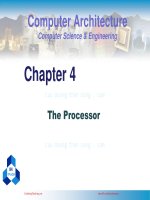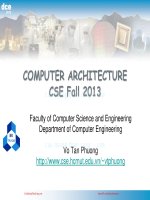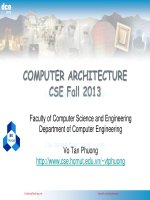kiến trúc máy tính võ tần phương assignmentignmentignmentignmentignment 1 solution sinhvienzone com
Bạn đang xem bản rút gọn của tài liệu. Xem và tải ngay bản đầy đủ của tài liệu tại đây (34.74 KB, 4 trang )
ICS 233 – Computer Architecture &
Assembly Language
Assignment 1 Solution: Computer Abstractions and Technology
1.
(5 pts) Find the word or phrase from the list below that best matches the description
in the following questions. Each answer should be used only once.
Control
Wafer
Embedded system
Digital Video Disk (DVD)
Instruction set architecture
Server
Datapath
Transistor
Assembler
Cache
DRAM
Abstraction
Yield
Defect
a) Approach to the design of hardware or software. The system consists of layers, with
each lower layer hiding details from the level above.
b) Computer inside another device used for running one predetermined application or
collection of software.
c) Interface that the hardware provides to the low-level software.
d) Integrated circuit commonly used to construct main memory.
e) Microscopic flaw in a wafer.
f) Percentage of good dies from the total number of dies on the wafer.
g) Small, fast memory that acts as a buffer for the main memory.
h) Thin disk sliced from a silicon crystal ingot, which will be later divided into dies.
i) Component of the processor that performs arithmetic operations.
j) Component of the processor that tells the datapath what to do according to the
instructions of the program.
k) On/Off switch controlled by electricity.
l) Computer used for running large programs for multiple users often simultaneously
and typically accessed only by a network.
m) Optical storage medium with a storage capacity of more than 4.7 GB.
n) Program that converts symbolic versions of instructions into their binary formats.
Solution:
a)
c)
e)
g)
i)
k)
m)
Abstraction
Instruction set architecture
Defect
Cache
Datapath
Transistor
Digital Video Disk (DVD)
b)
d)
f)
h)
j)
l)
n)
Embedded system
DRAM
Yield
Wafer
Control
Server
Assembler
Prepared by Dr. Muhamed Mudawar
CuuDuongThanCong.com
Page 1 of 4
/>
2.
(2 pts) Given a magnetic disk with the following properties: Rotation speed = 7200 RPM
(rotations per minute), Average seek = 8 ms, Sector = 512 bytes, Track = 200 sectors.
Calculate the following:
a) Time of one rotation (in milliseconds).
b) Average time to access a block of 32 consecutive sectors.
Solution:
a) Time of one rotation (7200 rpm) = 1 min / 7200 rotations = 60000 msec / 7200
Time of one rotation = 8.33 msec
b) Time to access a block of 32 consecutive sectors = 8 ms (average seek) +
8.33 ms / 2 (average rotation latency) + 32/200 * 8.33 (transfer time) =
8 + 4.17 + 1.33 = 13.5 msec
3.
(4 pts) The cost of an integrated circuit can be expressed in three simple equations:
Cost per wafer
Dies per wafer yield
Wafer area
Dies per wafter
Die area
1
Yield
(1 (Defects per area Die area/2)) 2
Cost per die
The following figure shows key statistics for DRAM production over 12 years:
Year
1980
1983
1985
1989
1992
Capacity
64K bits
256K bits
1024K bits
4096K bits
16384K bits
Die area
0.16 cm2
0.24 cm2
0.42 cm2
0.65 cm2
0.97 cm2
Wafer diameter
5 inches
5 inches
6 inches
6 inches
8 inches
Yield
48%
46%
45%
43%
48%
a) (1 pt) Given the increase in die area of DRAMs, what parameter must improve to
maintain yield?
b) (2 pts) Derive a formula for the improving parameter found in (a) from the other
parameters.
c) (1 pts) Using the formula in the answer to (b), what is the calculated improvement in
that parameter between 1980 and 1992?
Solution:
a) Yield = 1/(1 + Defects per area × Die area / 2)2
If die area is increased then to keep the yield constant, we must improve (reduce)
the defects per area.
Prepared by Dr. Muhamed Mudawar
CuuDuongThanCong.com
Page 2 of 4
/>
b) Yield = 1/(1 + Defects per area × Die area / 2)2
(1+ Defects per area × Die area / 2)2 = 1/Yield
(1 Defects per area Die area / 2)
1
Yield
2
1
Defects per area
1
Die area Yield
c) In 1980, Yield = 48%, Die Area = 0.16 cm2.
2 1
Defects per area
1 5.54 defects per cm 2
0.16 0.48
In 1992, Yield = 48%, Die Area = 0.97 cm2.
2 1
Defects per area
1 0.91 defects per cm 2
0.97 0.48
4.
(3 pts) Assume you are in a company that will market a certain IC chip. The fixed
costs, including R&D, fabrication and equipments, and so on, add up to $500,000.
The cost per wafer is $6000, and each wafer can be diced into 1500 dies. The die
yield is 50%. Finally, the dies are packaged and tested, with a cost of $10 per chip.
The test yield is 90%; only those that pass the test will be sold to customers. If the
retail price is 40% more than the cost, at least how many chips have to be sold to
break even?
Solution:
Number of good dies per wafer = 1500 × 0.5 = 750
Number of chips that are sold to customers per wafer = 750 × 0.9 = 675
Cost per wafer = $6000 + $10 × 750 = $13500
Retail price per wafer = $13500 × 1.4 = $18900 (40% more than the cost)
Retail price per chip = $18900 / 675 = $28
Let W be the total number of wafers that must be sold:
Total cost = $500,000 + $13,500 × W
Total retail price = $18,900 × W
To break even: $500,000 + $13,500 × W = $18,900 × W
W = 92.59 wafers
Number of chips that must be sold = 92.59 × 675 = 62,500 chips
5.
(2 pts) What are the unsigned and signed decimal values of the following binary and
hexadecimal numbers?
a) 10110110
Unsigned Value = 128 + 32 + 16 + 4 + 2 = 182
Signed Value = –128 + 32 + 16 + 4 + 2 = –74
Prepared by Dr. Muhamed Mudawar
CuuDuongThanCong.com
Page 3 of 4
/>
b) C1B3
Uunsigned Value = 12*163 + 162 + 11*16 + 3 = 49587
Signed Value = 49587 – 216 = -15949
(2 pts) Carry the following additions. Indicate whether there is a carry or overflow?
6.
1111
a)
11010010 (binary)
1 11
b)
+ 10111101 (binary)
A1CF (hexadecimal)
+ B2D3 (hexadecimal)
10001111
54A2
Carry = 1
Carry = 1
Overflow = 0
Overflow = 1
No overflow because operands
Yes, there is an overflow because
and result are negative
operands are negative, but result is > 0
(2 pts) Carry the following subtractions. Indicate whether there is borrow or overflow.
7.
11111111
a)
11010010 (binary)
- 10111101 (binary)
00010101
1111
b)
71CF (hexadecimal)
- B2D3 (hexadecimal)
BEFC
Borrow = 0
Borrow = 1
Overflow = 0
Overflow = 1
No overflow can occur because both
There is an overflow because result
operands are of the same sign
should be positive, not negative
Prepared by Dr. Muhamed Mudawar
CuuDuongThanCong.com
Page 4 of 4
/>









